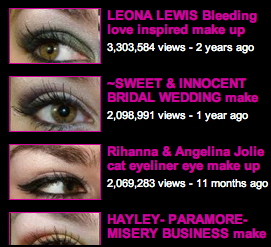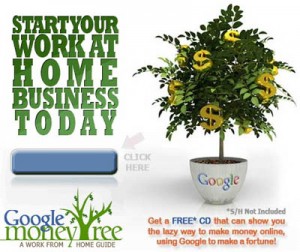Can online video make any money? I don’t remember right now, but I’m guessing the answers are in this Streaming Media Online Video “Redefining Monetization” expert panel that Larry Kless led. It’s an all-star cast and me. Just shut up and read his article from yesterday or watch an excerpt of the video, and make a funny comment on Larry’s blog.
Tag Archives: money
Obscure Makeup Artist Goes from YouTube to Makeup Line
This Today show report highlights Lauren Luke, a single mom from England who found fame via YouTube make-up tutorials. Now she’s making money on YouTube, and has launched her own makeup line with Sephora. Her own makeup talents are more evident by her glowing face in the in the live shot than the interview clips preceding it (which, perhaps due to careful NBC lighting direction, give her that requisite homely amateur look).
Check her out at YouTube as Panacea81 or see her fashion line here. If you last long enough in this video, you’ll see a rare quote from YouTube about the financial upside for creators. Go get ’em Lauren.
Lessons learned:
- Sometimes you can go from obscurity to a full-time revenue on YouTube.
- That can transcend to additional opportunities.
- NBC, like every other network, will never fail to show “Charlie Bit My Finger” or some of the other most-viewed videos whenever covering the medium.
- Eyes in thumbnails sell. See her most popular videos below:
Visit msnbc.com for breaking news, world news, and news about the economy
Exclusive: How Much Money YouTube Partners Make
{Update from 2013 reveals YouTube stars making $4 million plus per year}
How much do YouTube stars make each year? Oh for goodness sakes. Just like my same 5 YouTube videos (see right column of channel page here) represent the majority of my online views… It seems that most of WillVideoForFood’s blog traffic comes from people searching for how much YouTubers make. If you’re curious, read on. If you want to make big bucks, buy my book first. You’ll still be facing tough odds, but at least you’ll wander into the jungle equipped with some survival tools.
We YouTube “Partners” (or “stars” as I hate saying) are all contractually forbidden to share our revenue. But I’ve given hints and clues over time. For those of you who Googled your way here, I’m both a marketer/advertiser and a creator/YouTuber, so that gives me two lenses into this Da Vinci-Code like mystery. Davinci made me think of “Da Bears.”
I’d estimate there are have at least a few dozen YouTube Partners earning $100K per year. That’s great money if you’re in your 20s or 30s and have minimal costs in production or overhead (like 4 kids and a horrific mortgage). But it’s a rounding error for a professional content creator or network.
To calculate a particular Parner’s income, here are some tips:
- You basically take the Partner’s total views for the month, multiply it by a fraction of a penny, and you have a rough idea. TubeMogul‘s Marketplace shows some of the most-viewed people (and their monthly views). But remember: the most-subscribed are not necessarily most-viewed and vice versa. YouTube doesn’t give a hoot how many subscribers you have (although that certainly helps drive views, but increasingly it seems less powerful than being a “related video”). In general, the commercial content is getting more daily views but the amateurs have a lock on subscribers.
- Most ads are placed by advertisers based on total 1K views, but some is on a per-click basis (CPC text ads placed by Google Adwords/Adsense). Google/YouTube is usually paid by an agency or media buyer a CPM (cost per thousand, say between $5 and $25 dollars per thousand views), then shares some of that with the creator. This can be highly misleading, because:
- Some views earn nothing (if they’re embedded and no ad follows it).
- And increasingly advertisers are paying a high premium for specific content they commission, target, or hand select. Sometimes this might average a few bucks and others it might be much higher… $25 CMP was the published rate of InVideo ads and I know of specific integrated campaigns that command a higher premium from YouTube. Yey!
- Another confounding variable: potty-mouthed creator turns away advertisers. So watch the ads on your Partner for a while. Are they premium InVideo ads with accompanying display (square) ads? Or are they garbage Adwords/Adsense ads?
- The text ads may SOMETIMES be paid on a per-click basis, which can make them fruitless or profitable depending on people clicking and buying the advertiser’s product (the latter must occur, or a savvy advertiser will quickly stop the campaign that’s raping them of click dollars and not generating business). I was telling my YouTube buds to turn these off because they’re ugly and don’t make much money, but a few of them gave me a stern stare like they knew otherwise. So whatever… maybe they make money and maybe they don’t. I don’t get a breakdown on them, and they’re still ugly.
- Then you have to factor in “sponsored videos,” where a YouTuber promotes a product or service for a flat fee (or variable based on views) via Hitviews or related companies. That can easily be more than YouTube shells out per month for ad sharing. The going rate here is incredibly wide: from $1K to $20K and higher per video.
So in conclusion:
- Do your own math using monthly views on TubeMogul and assuming some CPM (cost per thousand), but recognize YouTube takes a cut and some of the advertising inventory isn’t sold or is driven by keyword Google adsense text thingies. Maybe the creator/partner gets a few bucks per thousand views and maybe more or less.
- Use some of the assumptions above to calibrate your estimate if you’re trying to peak into the W-9s of your favorite “Stars” like Fred. There are now dozens of popular YouTube people that make a full-time living on YouTube revenue, and I’d guess a lot of $50K-$100K per year people. I am not among the full-timers. With a family of 6, I gotta have a day job too. But Shaycarl, Sxephil, Charles Trippy, Michael Buckley and many more… they’re full-time at this. If I was making the bucks I’m making via YouTube after college, I’d probably go full-time too. Fred? Let’s just say he’s got college covered, or a nice nest-egg.
- Before you get excited (or jealous), it’s a long haul to cashville. And if you start with the hope of making money, you’re doomed. You need to LOVE it, and be extremely patient as the road to loads of views is tougher to climb, and requires an ass-load of persistence. Start as a hobby and “just keep swimming.”
- Finally, there are two forces at odds that impact the sustainability of this revenue for YouTube amateurs. First, we’ll probably see continued competition from more professionally-produced content that fetches higher ad dollars because it feels safer to squeamish media buyers (see, I’m not calling them all dense anymore… only the ones that don’t read this vlog). But the good news is that dollars are projected to grow dramatically. Currently, as a marketer, I’d argue that YouTube is selling itself short.
How’s that? About as specific I can be without breaking my contract or confidence from my friends.
I know some of you peeps know more than I do, so feel free to comment below anonymously or not. Da bears.
“One-Hit Wonder” Viral Videos Earn Cash: David at Dentist, Numa Kid, Charlie Bit Finger
So you got lucky and had a video go “viral.” Now what do you do?
YouTube is now giving “one-hit wonders” a chance to become a YouTube Partner, where they’re eligible to earn a percent of advertising revenue from their videos. This may, of course, be frustrating to those who have applied for the Partnership program, but have been refused — most likely because some of their videos contain copyright infringements, but sometimes perhaps because their videos aren’t garnering enough views to make it worthwhile for YouTube or the Partner.
But it makes sense, as the “David After Dentist” story illustrates. And remember that this is not new. Revver helped EeepyBird fetch more than $35,000 from the Diet Coke & Mentos video in 2006.
About 2 weeks after “David After Dentist” went viral (now at 28 million views), I received a nice note seeking advice from David’s dad (Booba1234). “We are still trying to process all this,” he said. “I am not looking to exploit David in anyway. However, we don’t want to miss an opportunity IF there is one.”
He even offered to pay me for help, and I told him he was silly. I referred him to the YouTube Partner peeps, encouraged him to monetize it (hey, college savings), but I wasn’t sure he’d get approved. My e-mail note said: “If your video had been monetized (already), you would have made a few hundred bucks (at that point). The trick is that joining the YouTube Partner program takes some time, and sometimes requires more videos…”
I was thrilled to see Booba1234 was put on a “fast track” and is now a YouTube Partner… but I can’t take credit.
In retrospect, I realize how easy it must have been for YouTube to say yes. At nearly 30 million views, “David at the Dentist” video has probably been viewed more times than the entire history of many existing YouTube Partner channels. It’s not “charity” to help one-hit wonders monetize. YouTube also profited from the viral sensations as soon as it was able to include the video in partner content (where it fetches exponentially more dollars per view than the mass of other content on its site).
The lesson? If you hit the “viral lottery” with a video, apply for a YouTube Partner account as quickly as possible. While YouTube historically accepted only established video creators who were “most subscribed” or posted videos fairly frequently, the company is eager to monetize the “long tail” of video content… and frankly some of these “viral one-hit wonders” qualify as part of the “short tail.” BUT don’t waste a lot of effort creating more content unless you enjoy it, or you have more video that will interest the same audience who devoured your one-hit wonder.
While it’s nice for these viralizers to have residual income from one video, few “one-hit wonders” have succeeded in evolving that into a broader platform. For example, David’s dad has only about 15K subscribers, and has posted just a few videos since “David at the Dentist” went viral 7 months ago (January 2009). He is trying to monetize his classic moment in other ways: offering the video for sale (via download) for $1.99, and a link to a t-shirt website (http://www.davidafterdentist.com), which is currently dead.
Similarly, the famed Gary Brolsma aka “Numa Numa kid” will enjoy continued revenue from his one-hit wonder (assuming they find his original and not the myriad of ripoffs). And his “return” video fetched a nice 13 million views. But his new channel (NewNuma) has under 35,000 subscribers and is basically distributing unrelated content by other creators, presumably who pay him for a cost-efficient way to access his residual audience.
And look at Cynthia Holmes’ Otters Holding Hands, which has partner ads but sits in a channel with fewer than 500 subscribers. She’s posted more videos of her kids, but they’re not getting noteworthy views.
Then there are some one-hit wonders like “Evolution of Dance” (YouTube’s most-viewed video) that infringes on copyrights and can’t likely be monetized. And dancer Jason Laipply has done precious little to extend his platform since (unless you count a sponsorship for Stopain under the guise of being an arthritis foundation video, which was viewed under 50,000 times.
An exception? The parents of “Charlie Bit My Finger” have an account, HDCYT, with 57,000 subscribers, and have continued to post well-viewed videos ranging from cute new ones to television recaps about Charlie. He’s also selling t-shirts. Perhaps there’s something enchanting about watching these kids grow up… a sharp contrast from the awkward return of Numa Numa or unrelated sequels to a cute otter moment.
The Google Money Tree
My sister is doing a story on the Google Money Tree, and I thought I’d write about it — if for no other reason — to scoop her and her “big media.”
I hadn’t heard of it before, so I googled it. Seems it’s a scam that locks you into a regular fee, and cost you to cancel. In fact the FTC tracked it down (see official site). The scammers claimed they were with Google, and had a way to make $100,000 in a year. Of course they didn’t tell you you’d be charged $72.21 a month.
Since the Google Money Tree’s website is surely gone (or at least not spidered by Google), here’s all you need to know: The FTC charge.
You know, instead of trying to get rich from a Google Money Tree scam, I suggest just making a donation to me. You’re guaranteed to receive no service or product in return, but also be free from any scams, additional upsells, or life-time membership dues. Plus if you go for the most-popular “Gold” level plan ($20) you’re likely to receive good luck within 2-3 days.
Secrets and Scams to Save Money in College (and beyond)
A special video for you WillVideoforFood subscribers, and the secret members of the UncleNalts family. How to scam your way to saving money in college (and beyond). Some of my tips to help you waltz along life without playing by the rules of everyone else (okay that was a joke).
How to save money, sneak into events, avoid parking tickets, hide stuff in dorms, fake IDs, use bathrooms, get discounts on cars and hotels, get into a restaurant without a reservation, get liquids on a plane, get out of some speeding tickets, save cash at a movie, and more…
Please DIGG THIS PAGE if you like it. I want to see if Digg still works.
It may be almost 8 minutes long, but I guarantee you’ll learn something new that pays. Or you can have your 8 minutes back… no questions asked. Well at least it’s add free. Because UncleNalts don’t run no ads, and he’s no big-headed “partner.” No sir. He’s just your crazy Uncle, and you may be glad he’s not your dad… but he always makes reunions a bit more interesting.
Top 5 Secrets to Profit Via Online Video
Yesterday I outlined the 5 magical secrets to making money via online video. I made it up while driving to NYC from my rural PA home, and used a forced “NALTS” acronym. It was the only way I’d remember it on stage at the Digital Content NewFront, and I still had to check my hat lid, where I had written them down as an emergency.
Hopefully the audience remembers these tips more than my pratfall, fart machine, and spinning beer caps.
You can also check out my free eBook (“How to Become Popular on YouTube Without Any Talent“).
- Nickle: Keep it cheap. The “one man band” will always do better than a crew. I couldn’t have quit my day job if I had to share my YouTube revenue with a writer, editor, producer, agent and actors. Just me, a camera, and unpaid “actors.”
- Amplify: There’s no online-video “prime time.” A homepage video on YouTube won’t guarantee an audience. You need to promote, collaborate, get involved with the community (the eBook gives you tips).
- Listen: It’s not distribution it’s dialogue. Listen, react, talk back. Don’t “Oprahize” YouTube and use online-video for trailers. Get on camera and interact with the audience. Do collaborations with other famous peeps.
- Theater: Go where the crowds are: Be in Regal not a tiny cinema. Fish where the fish are. YouTube. Use TubeMogul to post more broadly, but no f’ing microsites. As a marketer, I want my ad on the highway, not on some rest stop.
- Sponsor: Bring your own sponsor. The money on CPM buys isn’t as interesting. Build content that’s entertaining but targeted to a niche that advertisers want to reach (moms, cooks, fisherman, financial, whatever). You can’t get a sponsor easily unless you have an audience, and if you’d rather let someone else hunt for the sponsor than check out Hitviews (disclaimer: I am its chief strategical officer).
There. Now go get rich. But as a reminder, if you’re focused on making money I would advise writing blogs about mortgage or investing. It’s very hard still to profit via online video, whether you’re talented or not.
I’m clearly motivated by sources other than money. I’ll have to ask a therapist what those motivations are.
Michael Buckley: Making a Living as YouTube Star
Michael Buckley was on CNN discussing the YouTube Partnership program, and how it has allowed him to follow his passion full-time. I’m hoping Buckley’s recent press can remind people of two things. First, this space has grown up. I predicted people would be earning 6-figure incomes in 2007 and I was too ambitious. But now folks like KipKay on Metacafe (who earned 6-figures last year, but has slowed down significantly) and Michael Buckley (WhattheBuckShow) are proving that it’s possible. Second, Buckley reminds us to be realistic. Buckley worked like crazy, has crowd-gathering talent, and promotes himself well. Buckley is on Inside Edition tonight, and the media seems rather interested in the notion that people can quit their jobs and live independently via YouTube.
Want to make a living on YouTube? Some tips
- Remember it won’t happen overnight.
- Find a niche. Buckley is appealing to celebrity-watchers that like a regular online digest.
- Read my free eBook: How to Become Popular on YouTube Without Any Talent
- Promote yourself, and ensure you use copyright-free content.
- RSS or read this blog often- it’s dedicated to helping creators make income (and show advertisers how to enhance their brands via known YouTube creators.
- Join the YouTube Partners program once you have a decent amount of videos and views
- Create a lot of content that people want- much of Buckley’s revenue is due to his constantly topical videos, and residual income he earns from his collection. For instance, the vast majority of my income comes from continuous views to the top videos I’ve created that continue to get views.
You’ll need to be a top YouTube creator to live from its advertising sharing, but many of us are supplementing our income. I maintain that the highest earning comes from “sponsored videos.” These aren’t easy to find, but they’re nice income.
Buckley had a modest income before going full-time, and that helps. I’ve got four kids and a mortgage, so it will be a while before YouTube can match my day-job income. But it’s a fun way to make an additional income source, and my video revenue is certainly more than I made in my first job post MBA.
Should a Brand Be a Publisher?
I advocate that brands participate in online-video, but by partnering with those already “in the house.” But I struggle when I see Zappos becoming a publisher. Or Bank of America developing a financial-advice channel (and surprisingly co-branding it with YouTube).
Whatya think?
YouTube Technical Problems Create Pissed Unpaid “Partner”
 He’s one of the most prolific YouTubers with more than 123,000 subscribers, daily comedic and topical rants, and he makes his primary income from YouTube’s “Partner Program.”
He’s one of the most prolific YouTubers with more than 123,000 subscribers, daily comedic and topical rants, and he makes his primary income from YouTube’s “Partner Program.”
But Sxephil was so frustrated by YouTube’s technical problems — which he said deprived him of ad revenue — that he turned his daily rant toward the Google-owned video site, YouTube. YouTube provides him with shared advertising revenue that some estimate could amount to a 6-figure annual salary.
Last night (May 17), the YouTube Comedian noticed his recent videos lacked advertisements, and likened the glitch to someone arriving at work and finding their paycheck wasn’t processing. He has since removed that video, but his blog post “Bastards” shows a screen shot of his YouTube midget/prostitute video without ads.
It’s not yet clear if SxePhil removed his YouTube rant video because the site has resolved the issue, or whether it was a reaction to his viewers (some the YouTube’s community took issue with his perceived entitlement). He also might have had second thoughts about “biting the hand,” but his blog isn’t commenting about why the video was removed by him, or even if he removed it.
SxePhil, or “Phil DeFranco” (see PhillyD.tv) also was not available at press time for his comments. But to be fair… I didn’t try to reach him (one of the joys of being a blogger instead of a journalist). I’ve had the pleasure of meeting him at a Washington, D.C. gathering, and his true personality is miles from his on-screen persona. I’ve heard the same observation from dozens of people, including a documentary film maker that agreed he’s the YouTuber whose real self is most unlike his on-screen persona.
Last night’s video not only blurred the lines between DeFranco (if indeed that’s his real name) and SxePhil (pronounced “es-exy-phil”). It also created an interesting bifurcation of opinion, which took place on the YouTube video’s comments, in private e-mails among the community, and in live Stickam discussions last night.
- On one hand, Phil devotes most of his day to creating a short, daily video show. He’s paid only if people view his videos, and in direct proportion to those views. If Google fails to run the ads due to technical errors, both Google and Phil aren’t paid. Counter this to a television network that buys rights to a show and doesn’t sell or run advertising. My guess is the show’s producer is still paid. Another analogy would be a wholesaler that buys pottery from a local artist, and damages them all in a truck accident. Naturally the wholesaler would take the loss, while the artist would still be paid.
- On the other hand, Phil reminded his audience that he’s paid by YouTube while many of them aren’t, which leads to inevitable (and often deep) resentment. Most YouTubers are hobbiests or at best part-time YouTubers (even the increasingly popular Michael Buckley “What the Buck” has a day job). Members of the community don’t like the idea of one YouTuber not needing a job, while they go to work each day. This resentment is not as true for audiences of television or movie stars, who are often paid for one film what many of us won’t make in a lifetime. But since YouTube has a grassroots community origin, the audience sees itself in an equal peer group with the creators — even when fellow creators are propelled to top rankings. When I first campaigned to be in YouTube’s partner program (with a NAPPY video I haven’t since watched), I felt that community ire and resentment. YouTube viewers begin to expect more from videos of paid creators (an odd entitlement since they’re not paying to watch), yet Phil’s rant was viewed as a pompous entitlement of its own. Interesting?
I’ll be interested in the comments on this post since the video’s gone and so are many of the public reactions. I imagine the common denominator would be that Phil has a right to his earnings, but it might have been more diplomatic to work “behind the scenes” to resolve the issue. That said, YouTube is a company, and companies run on company time. So sometimes the squeaky wheel gets oiled. Thoughts?







